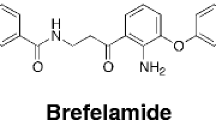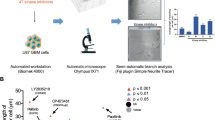Abstract
Glioma remains one of the most lethal human tumors in spite of the progress in radiotherapy, chemotherapy, and surgical techniques. Cell differentiation agent-2 (CDA-2) is an extraction from healthy human urine consisting of primary organic acids and peptides, and it has been demonstrated to inhibit growth and induce differentiation in glioma and other cell lines. However, the mechanism remains unclear. Peroxisome proliferator-activated receptors (PPARs) are members of the nuclear hormone receptors (NHRs) which are involved in cellular differentiation and proliferation. In this study, we investigated if CDA-2 induced differentiation of SWO-38 glioma cells is mediated by PPARγ. CDA-2 induced differentiation of SWO-38 cells was characterized by typical morphological changes, increased expression of GFAP, inhibition of proliferation and G0/G1 cell cycle arrest. CDA-2 also triggered up-regulation of PPARγ, GFAP and PTEN protein and a reduction of COX-2 protein. However, the effects of CDA-2 on SWO-38 cells could be partly reversed by GW9662, an irreversible PPARγ antagonist. Our investigation demonstrated that CDA-2 could be a potential drug for tumor differentiation therapy, and activation of the PPARγ pathway might be a crucial factor in glioma differentiation induced by CDA-2.






Similar content being viewed by others
References
Kleihues P, Louis DN, Scheithauer BW, Rorke LB, Reifenberger G, Burger PC, Cavenee WK (2002) The WHO classification of tumors of the nervous system. J Neuropathol Exp Neurol 61:215–225 (discussion 226–219, 2002)
Stupp R, Mason WP, van den Bent MJ, Weller M, Fisher B, Taphoorn MJ, Belanger K, Brandes AA, Marosi C, Bogdahn U, Curschmann J, Janzer RC, Ludwin SK, Gorlia T, Allgeier A, Lacombe D, Cairncross JG, Eisenhauer E, Mirimanoff RO (2005) Radiotherapy plus concomitant and adjuvant temozolomide for glioblastoma. N Engl J Med 352:987–996. doi:10.1056/NEJMoa043330
Leszczyniecka M, Roberts T, Dent P, Grant S, Fisher PB (2001) Differentiation therapy of human cancer: basic science and clinical applications. Pharmacol Ther 90:105–156. doi:10.1016/S0163-7258(01)00132-2
Wang ZY, Chen Z (2000) Differentiation and apoptosis induction therapy in acute promyelocytic leukaemia. Lancet Oncol 1:101–106. doi:10.1016/S1470-2045(00)00017-6
Kinjo K, Kizaki M, Muto A, Fukuchi Y, Umezawa A, Yamato K, Nishihara T, Hata J, Ito M, Ueyama Y, Ikeda Y (2000) Arsenic trioxide (As2O3)-induced apoptosis and differentiation in retinoic acid-resistant acute promyelocytic leukemia model in hGM-CSF-producing transgenic SCID mice. Leukemia 14:431–438. doi:10.1038/sj.leu.2401646
Wang HY, Zhong XY, Tu YS, Liu ZZ (2006) Effect of CDA-II on the differentiation and inhibition of human glioma cell lines SWO-38. Chin Pharm Bull 22:184–188
Yao CJ, Lai GM, Chan CF, Yang YY, Liu FC, Chuang SE (2005) Differentiation of pheochromocytoma PC12 cells induced by human urine extract and the involvement of the extracellular signal-regulated kinase signaling pathway. J Altern Complement Med 11:903–908. doi:10.1089/acm.2005.11.903
Xin Y, Xu KS (2001) HPLC determination of peptide’s molecular weight in Niaoduosuantai (CDA-II) injection. Chin J Pharm Anal 21:191–193
Warrell RP Jr, Frankel SR, Miller WH Jr, Scheinberg DA, Itri LM, Hittelman WN, Vyas R, Andreeff M, Tafuri A, Jakubowski A et al (1991) Differentiation therapy of acute promyelocytic leukemia with tretinoin (all-trans-retinoic acid). N Engl J Med 324:1385–1393
Kinzler KW, Vogelstein B (1996) Lessons from hereditary colorectal cancer. Cell 87:159–170. doi:10.1016/S0092-8674(00)81333-1
Sarraf P, Mueller E, Smith WM, Wright HM, Kum JB, Aaltonen LA, de la Chapelle A, Spiegelman BM, Eng C (1999) Loss-of-function mutations in PPAR gamma associated with human colon cancer. Mol Cell 3:799–804. doi:10.1016/S1097-2765(01)80012-5
Mossner R, Schulz U, Kruger U, Middel P, Schinner S, Fuzesi L, Neumann C, Reich K (2002) Agonists of peroxisome proliferator-activated receptor gamma inhibit cell growth in malignant melanoma. J Invest Dermatol 119:576–582. doi:10.1046/j.1523-1747.2002.01861.x
Yang WL, Frucht H (2001) Activation of the PPAR pathway induces apoptosis and COX-2 inhibition in HT-29 human colon cancer cells. Carcinogenesis 22:1379–1383. doi:10.1093/carcin/22.9.1379
Zang C, Liu H, Posch MG, Waechter M, Facklam M, Fenner MH, Ruthardt M, Possinger K, Phillip Koeffler H, Elstner E (2004) Peroxisome proliferator-activated receptor gamma ligands induce growth inhibition and apoptosis of human B lymphocytic leukemia. Leuk Res 28:387–397. doi:10.1016/j.leukres.2003.07.005
Ding Q, Jin T, Wang Z, Chen Y (2007) Catalase potentiates retinoic acid-induced THP-1 monocyte differentiation into macrophage through inhibition of peroxisome proliferator-activated receptor gamma. J Leukoc Biol 81:1568–1576. doi:10.1189/jlb.1106672
Ricote M, Li AC, Willson TM, Kelly CJ, Glass CK (1998) The peroxisome proliferator-activated receptor-gamma is a negative regulator of macrophage activation. Nature 391:79–82. doi:10.1038/34178
Spiegelman BM, Hu E, Kim JB, Brun R (1997) PPAR gamma and the control of adipogenesis. Biochimie 79:111–112. doi:10.1016/S0300-9084(97)81500-3
Grimaldi PA, Teboul L, Inadera H, Gaillard D, Amri EZ (1997) Trans-differentiation of myoblasts to adipoblasts: triggering effects of fatty acids and thiazolidinediones. Prostaglandins Leukot Essent Fatty Acids 57:71–75. doi:10.1016/S0952-3278(97)90495-6
Rivier M, Safonova I, Lebrun P, Griffiths CE, Ailhaud G, Michel S (1998) Differential expression of peroxisome proliferator-activated receptor subtypes during the differentiation of human keratinocytes. J Invest Dermatol 111:1116–1121. doi:10.1046/j.1523-1747.1998.00439.x
Tontonoz P, Nagy L, Alvarez JG, Thomazy VA, Evans RM (1998) PPARgamma promotes monocyte/macrophage differentiation and uptake of oxidized LDL. Cell 93:241–252. doi:10.1016/S0092-8674(00)81575-5
Zander T, Kraus JA, Grommes C, Schlegel U, Feinstein D, Klockgether T, Landreth G, Koenigsknecht J, Heneka MT (2002) Induction of apoptosis in human and rat glioma by agonists of the nuclear receptor PPARgamma. J Neurochem 81:1052–1060. doi:10.1046/j.1471-4159.2002.00899.x
Situ R, Wang HH, Wang JH, He LP, Zhu XL, Ou WF (1987) Establishement of human brain malignant glioma cell line(SWO-38) and observation of its biologic properties. Chin J Cancer 6:235–238
Roymans D, Vissenberg K, De Jonghe C, Grobben B, Claes P, Verbelen JP, Van Broeckhoven C, Slegers H (2001) Phosphatidylinositol 3-kinase activity is required for the expression of glial fibrillary acidic protein upon cAMP-dependent induction of differentiation in rat C6 glioma. J Neurochem 76:610–618. doi:10.1046/j.1471-4159.2001.00077.x
Elnemr A, Ohta T, Iwata K, Ninomia I, Fushida S, Nishimura G, Kitagawa H, Kayahara M, Yamamoto M, Terada T, Miwa K (2000) PPARgamma ligand (thiazolidinedione) induces growth arrest and differentiation markers of human pancreatic cancer cells. Int J Oncol 17:1157–1164
Elstner E, Muller C, Koshizuka K, Williamson EA, Park D, Asou H, Shintaku P, Said JW, Heber D, Koeffler HP (1998) Ligands for peroxisome proliferator-activated receptorgamma and retinoic acid receptor inhibit growth and induce apoptosis of human breast cancer cells in vitro and in BNX mice. Proc Natl Acad Sci USA 95:8806–8811. doi:10.1073/pnas.95.15.8806
Laidler P, Dulinska J, Mrozicki S (2007) Does the inhibition of c-myc expression mediate the anti-tumor activity of PPAR’s ligands in prostate cancer cell lines? Arch Biochem Biophys 462:1–12. doi:10.1016/j.abb.2007.03.013
Cimini A, Cristiano L, Colafarina S, Benedetti E, Di Loreto S, Festuccia C, Amicarelli F, Canuto RA, Ceru MP (2005) PPARgamma-dependent effects of conjugated linoleic acid on the human glioblastoma cell line (ADF). Int J Cancer 117:923–933. doi:10.1002/ijc.21272
Bocca C, Bozzo F, Francica S, Colombatto S, Miglietta A (2007) Involvement of PPAR gamma and E-cadherin/beta-catenin pathway in the antiproliferative effect of conjugated linoleic acid in MCF-7 cells. Int J Cancer 121:248–256. doi:10.1002/ijc.22646
Zheng H, Ying H, Yan H, Kimmelman AC, Hiller DJ, Chen AJ, Perry SR, Tonon G, Chu GC, Ding Z, Stommel JM, Dunn KL, Wiedemeyer R, You MJ, Brennan C, Wang YA, Ligon KL, Wong WH, Chin L, DePinho RA (2008) p53 and Pten control neural and glioma stem/progenitor cell renewal and differentiation. Nature 455:1129–1133. doi:10.1038/nature07443
Lu S, Yu G, Zhu Y, Archer MC (2005) Cyclooxygenase-2 overexpression in MCF-10F human breast epithelial cells inhibits proliferation, apoptosis and differentiation, and causes partial transformation. Int J Cancer 116:847–852. doi:10.1002/ijc.21142
Shono T, Tofilon PJ, Bruner JM, Owolabi O, Lang FF (2001) Cyclooxygenase-2 expression in human gliomas: prognostic significance and molecular correlations. Cancer Res 61:4375–4381
Patel L, Pass I, Coxon P, Downes CP, Smith SA, Macphee CH (2001) Tumor suppressor and anti-inflammatory actions of PPARgamma agonists are mediated via upregulation of PTEN. Curr Biol 11:764–768. doi:10.1016/S0960-9822(01)00225-1
Teresi RE, Shaiu CW, Chen CS, Chatterjee VK, Waite KA, Eng C (2006) Increased PTEN expression due to transcriptional activation of PPARgamma by Lovastatin and Rosiglitazone. Int J Cancer 118:2390–2398. doi:10.1002/ijc.21799
Farrow B, Evers BM (2003) Activation of PPARgamma increases PTEN expression in pancreatic cancer cells. Biochem Biophys Res Commun 301:50–53. doi:10.1016/S0006-291X(02)02983-2
Meade EA, McIntyre TM, Zimmerman GA, Prescott SM (1999) Peroxisome proliferators enhance cyclooxygenase-2 expression in epithelial cells. J Biol Chem 274:8328–8334. doi:10.1074/jbc.274.12.8328
Subbaramaiah K, Lin DT, Hart JC, Dannenberg AJ (2001) Peroxisome proliferator-activated receptor gamma ligands suppress the transcriptional activation of cyclooxygenase-2. Evidence for involvement of activator protein-1 and CREB-binding protein/p300. J Biol Chem 276:12440–12448. doi:10.1074/jbc.M007237200
Kosaka T, Miyata A, Ihara H, Hara S, Sugimoto T, Takeda O, Takahashi E, Tanabe T (1994) Characterization of the human gene (PTGS2) encoding prostaglandin-endoperoxide synthase 2. Eur J Biochem 221:889–897. doi:10.1111/j.1432-1033.1994.tb18804.x
St-Germain ME, Gagnon V, Parent S, Asselin E (2004) Regulation of COX-2 protein expression by Akt in endometrial cancer cells is mediated through NF-kappaB/IkappaB pathway. Mol Cancer 3:7. doi:10.1186/1476-4598-3-7
Acknowledgements
This research was supported by National Natural Science Foundation of China (No. 30670795) and Natural Science Foundation of Guangdong Province, China (No. 06025208). We thank Bin Du, Kaishan Liu, Penge Zheng and Ying Zhong for excellent technical assistance and continued support of this work. We thank Everlife Pharmaceutical Co. Ltd. (Hefei, China) for providing CDA-2.
Author information
Authors and Affiliations
Corresponding author
Additional information
Chen-Li Lin and Ming-Hua Wang contributed equally.
All authors have read and approved the final manuscript, Chen-Li Lin set up the protocols. Ming-Hua Wang contributed in the experimental procedures. Mao Fang and Bin-Bin Xie gave advice on the work and helped in the interpretation of the data. Xue-Yun Zhong supervised all the work and wrote the manuscript together with Chen-Li Lin and Ming-Hua Wang.
Rights and permissions
About this article
Cite this article
Lin, C.L., Wang, M.H., Qin, Y.F. et al. Differentiation of SWO-38 glioma cells induced by CDA-2 is mediated by peroxisome proliferator-activated receptor γ. J Neurooncol 95, 29–36 (2009). https://doi.org/10.1007/s11060-009-9900-x
Received:
Accepted:
Published:
Issue Date:
DOI: https://doi.org/10.1007/s11060-009-9900-x




